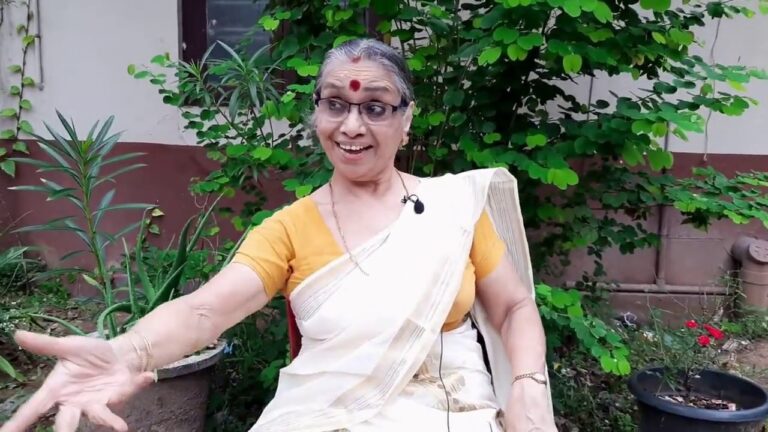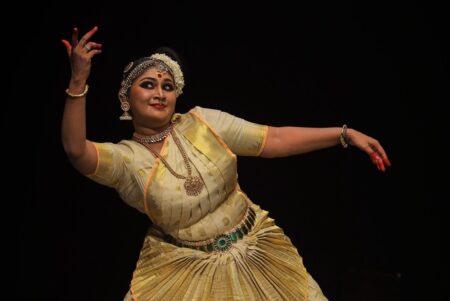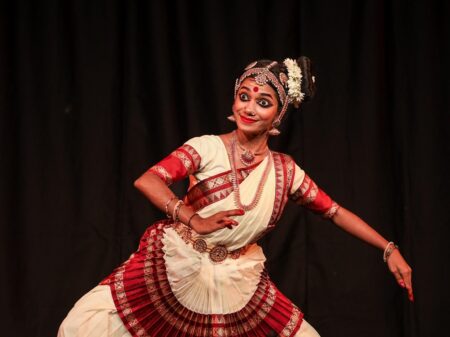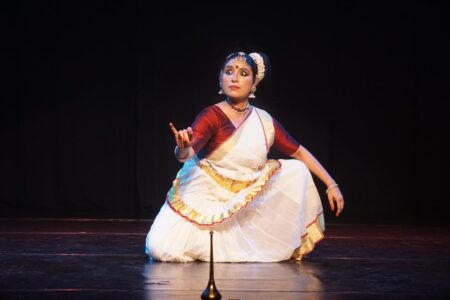Renowned Mohiniyattam dancer, guru, choreographer and writer, Kala Vijayan requires no introduction. Born to Kalamandalam Kalyanikutty Amma, the matriarch of Mohiniyattam, and Kathakali exponent Kalamandalam Krishnan Nair, she was immersed in the world of dance from a young age. At the age of 80, her passion for learning and research remains undiminished. Recently honored with the Sangeet Natak Akademi Award for her significant contributions to Mohiniyattam, she graciously shares insights in a candid interview. From reminiscing about her mother’s nurturing influence to discussing the distinctive traits of the Kalyanikuttiyamma style, she offers a glimpse into her artistic journey and aspirations for expanding the horizons of this lyrical art form.
During Kalamandalam’s Mohiniyattam revival, Vallathol faced societal opposition due to its perceived lack of dignity. Kalamandalam Kalyanikutty Amma stepped up to learn it, and later, Vallathol entrusted her to continue his mission. How did learning from the mother of Mohiniyattam shape your early days?
During that era, Mohiniyattam lacked classical rigor and was perceived as merely a dance form lacking substantial dignity. Even though Vallathol revived it, the transition to a classical format did not occur. After completing her training at Kalamandalam, she began teaching and embarked on a mission to give Mohiniyattam structure and form through extensive research and experimentation.
When I was a child, my parents, who were Kathakali and Mohiniyattam teachers, frequently relocated for their work. Naturally drawn to dance, I closely observed my mother’s teaching methods, as her classes were often held at our residence. At the age of four, I began structured learning at her Kalari, and had my arangettam at the age of eight.
Did you learn only Mohiniyattam?
No. Initially, I also studied Bharatanatyam under Thanjavur ARR Bhaskar, a renowned nattuvar who came to Kerala to teach Bharatanayam. He was deeply rooted in the Thanjavur tradition. I also learned Kathakali. By the age of 14, I had arangettam in both. However, later, I discontinued them and concentrated only on Mohiniyattam.
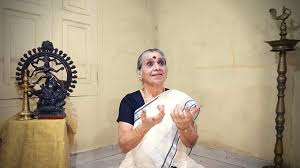
Returning to Kalyanikutty Amma, could you recall how she restructured the art form?
Initially, Mohiniyattam had only a few bhavams, such as sringaram, shokam, and hasyam. However, my mother aimed to expand its expression to include all the navarasas. She successfully choreographed a padam featuring all the rasas, which was well appreciated boosting her confidence. Drawing insights from our Bharatanatyam classes, she identified the need to include diverse steps and adavus into Mohiniyattam. Merging steps from Kaikottikali and mudras from Hastalakshna Deepika, she meticulously crafted the 32 adavus and charis at first. She travelled to various places, collected documents and did a lot of research that inspired in the creation of new compositions like thillanas and padams. She structured Mohiniyattam into a kucheri format, starting with Ganapathi stuthi and advancing through cholkettus, jathiswarams, varnams, padams, slokams, saptam, and thillana.
Various styles evolved in Mohiniyattam later. How were they different?
Many prominent Mohiniyattam artists, including Kanak Rele, had taken lessons from her. Kanak Rele, for instance, filmed all her adavus and thillanas for research purposes and later modified them to establish the Kanak Rele style. Similarly, Bharati Shivaji also built upon what she had learned from Kalyanikutty Amma’s school. Kalamandalam Satyabhama also underwent training under my mother, eventually developing the Kalamandalam style based on these teachings. While all these trace their origins to my mother’s instruction, each has evolved into distinct styles.
Kalyanikutty Amma style notably differs, especially in hairstyle. Could you elaborate?
Indeed, Kalyanikutty Amma staunchly upheld traditional hairstyles, rooted in the devadasi system’s legacy, distinct from the kondakettu favored by other styles. Our style emphasizes meticulous detailing and immersive abhinaya, prioritizing narrative comprehension before instruction.
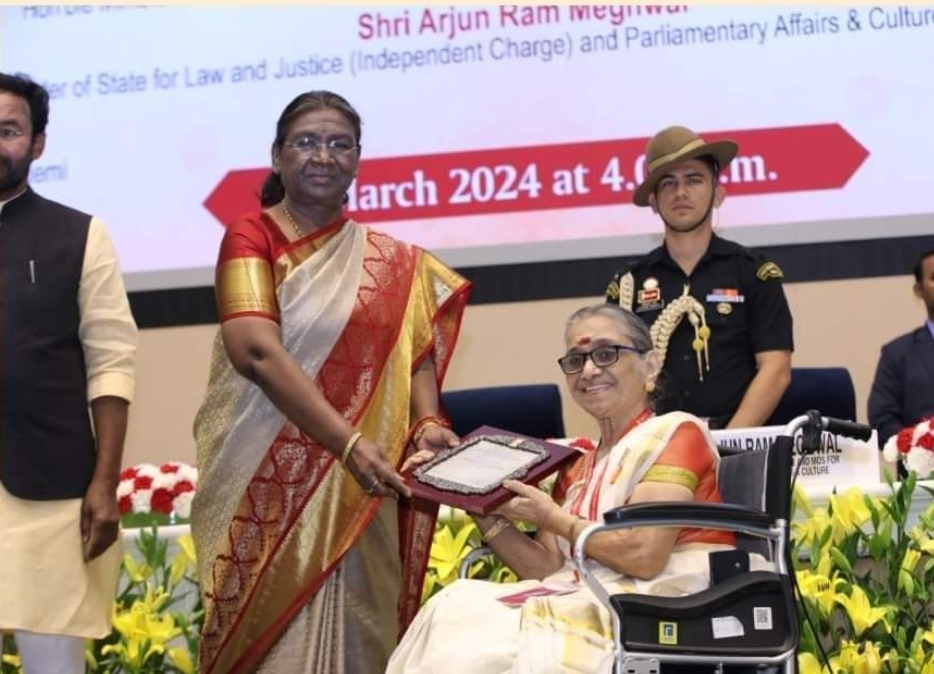
While my mother was studying in Kalamandalam under Krishna Paniker, another girl named Shanta Rao was also learning. Inspired by Raja Ravi Varma’s paintings, she suggested the Kondakettu hairstyle. However, Ashan opposed it, stating that this hairstyle was more appropriate for akathamma and not suited for the arangu. Perhaps in the devadasi system, from which Mohiniyattam and other dance forms evolved, dancers used to tie their hair backwards, and he believed this to be the most suitable style for dance. Later, when Kalamandalam adopted the Kondakettu hairstyle, my mother adhered to the traditional style.
Yet, the uniqueness of the Kalyanikutty Amma style extends beyond hairstyling. It includes distinct body movements, eye expressions, and footwork. Following the principles outlined in Abhinayadarpanam, “Yatho Hasta thatho Drishti
Yatho Drishti thatho Manah
Yatho Manah thatho Bhaava
Yatho Bhaava thatho Rasa”
My mother devised a nrithakramam for Mohiniyattam. That says “ Kai chalikkum nerathekkum kannum meyyum orevidham vannale paripoornatwam kaivaroo”.
This emphasizes meticulous attention to detail in conveying emotions. When teaching our students, we first narrate the storyline, then explain the meaning of the lyrics, and finally delve into the nuances of expression, ensuring a holistic abhinaya.
Did Krishnan Nair’s Kathakali influence this style?
While it’s a common assumption given her husband’s background, Kalyanikutty Amma style is not anchored on Kathakali. She said Kathakali is like an epic novel, rich in elaborate gestures and expressions, while Mohiniyattam, in contrast, is akin to a short story—lighter and more graceful. Despite the shared vocabulary of gestures, the essence of Kathakali and Mohiniyattam diverges fundamentally, with the latter epitomiding the concept of ‘lasya’, or graceful femininity. However, learning Kathakali helped me, particularly in choreography, where familiarity with mudras proved invaluable.
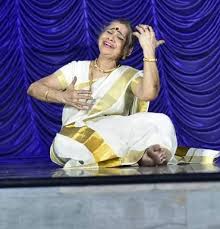
Should style be strictly adhered to?
When a student learning from multiple gurus at various stages, stylistic influences naturally blend. As dancers mature, they include elements they find appealing, leading to the emergence of new styles. This evolution is crucial for the growth of the art form. Personally, I believe in embracing this, as it helps innovation and prevents stagnation of art. Ultimately, the priority lies in the growth and dissemination of the art form, rather than rigid adherence to specific styles. While some experiments may yield positive results, others, like the use of unconventional coloured costumes in Mohiniyattam, may not be as well-received.
Tell us about your research and writing.
Observing my mother’s compositional process and research methods closely has greatly influenced my own work. I have composed several pieces, including 17 padams, four varnams, ganapathi stuthis, three cholkettus, thillanas, slokams, saptam, and one jathiswaram. I also have choreographed many compositions of Swathi Tirunal and Thyagaraja. I have done research on comparison of hastaprayogas in Mohiniyattam and Kathakali, the relationship between Yoga and Dance, and the significance of thantrika hastas. All these experiences prompted me to write the book “Mohiniyattam Araiyendathellam,” which includes theoretical and practical lessons. We also launched a YouTube channel to propagate Mohiniyattam to the younger generation during the Covid pandemic.
Currently, I am working on a new choreography based on the Panchabhoota elements, inspired by the Panchabhoota Linga kritis of Muthuswami Deekshitar. Apart from these, I have also written poems in Malayalam which will soon be published as a book.
What inspires you to choreograph across diverse cultural narratives?
Art has no barriers of region, religion, language, or politics. As Natyashastra suggests, art serves to guide people on the right path. I have choreographed pieces for Tamil and Telugu kritis, and for stories beyond Hindu mythology. For instance, I composed Mohiniyattam based on the story of Job from the Old Testament of the Bible for my student RLV Jolly Mathew. I also choreographed Mohiniyattam for the famous film song “Kanivolum Kamaneeya Hridayam” from the movie Snehaseema. Currently, I am working on choreographing a Tamil composition.
How do you feel after receiving the Sangeet Natak Akademi Award?
Receiving appreciation validates an artist’s efforts. Each award acts as a milestone, inspiring further dedication and improvement.

